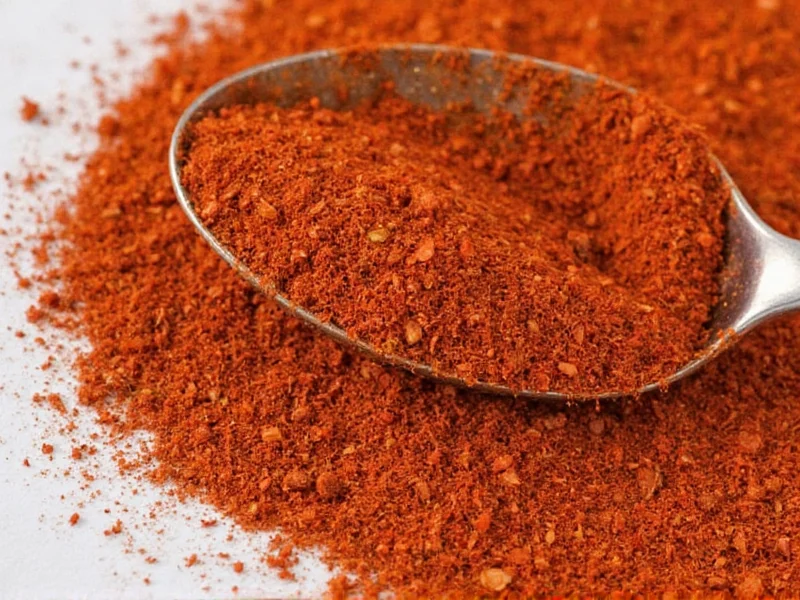Understanding what's in chili seasoning helps home cooks recreate authentic flavors and customize blends to their taste preferences. Unlike single-ingredient chili powder, chili seasoning is a carefully balanced spice mix designed specifically for preparing chili dishes, tacos, and other Southwestern recipes.
Core Components of Traditional Chili Seasoning
Chili seasoning blends combine several spices that work synergistically to create the distinctive flavor profile associated with chili con carne and other Tex-Mex dishes. The foundation of most chili seasoning recipes consists of:
| Ingredient | Flavor Contribution | Typical Percentage |
|---|---|---|
| Chili Powder | Base flavor, mild heat, earthiness | 30-40% |
| Cumin | Earthy, warm, slightly smoky notes | 20-25% |
| Garlic Powder | Savory depth, umami | 10-15% |
| Onion Powder | Sweetness, aromatic complexity | 10-15% |
| Dried Oregano | Herbal, slightly bitter notes | 5-10% |
| Paprika | Color, mild sweetness, subtle heat | 5-10% |
| Salt | Flavor enhancer, balances other elements | 5-10% |
Differentiating Chili Powder from Chili Seasoning
Many people confuse chili powder and chili seasoning, but they're distinct products. Chili powder is primarily ground dried chilies (like ancho, cayenne, or New Mexico peppers) with little to no additional spices. In contrast, chili seasoning is a complete spice blend specifically formulated for chili recipes.
When examining commercial products, check the ingredient list carefully. Authentic chili seasoning should list multiple spices rather than just 'chili powder' as the primary ingredient. This distinction matters significantly when following recipes that specify one or the other.
Regional Variations in Chili Seasoning Blends
Chili seasoning recipes vary considerably across different regions of the United States and Mexico:
- Texas-style: Focuses on chili peppers, cumin, and garlic with minimal additional spices—often no oregano
- New Mexico: Features locally grown red chilies with more pronounced heat and earthiness
- Commercial blends: Often include additional ingredients like sugar, cornstarch, or anti-caking agents
- Homemade versions: Typically contain only pure spices without fillers
Understanding these regional differences helps explain why chili seasoning from different sources can produce dramatically different results in your cooking.
Creating Your Own Homemade Chili Seasoning
Making your own chili seasoning blend offers several advantages over store-bought versions. You control the quality of ingredients, adjust heat levels to your preference, and avoid unnecessary additives. Here's a basic recipe for a versatile homemade chili seasoning:
- Combine ¼ cup chili powder (ancho preferred for depth)
- Add 2 tablespoons ground cumin
- Mix in 1½ tablespoons garlic powder
- Incorporate 1½ tablespoons onion powder
- Add 1 tablespoon dried oregano (Mexican oregano if available)
- Include 1 tablespoon paprika
- Add 1½ teaspoons salt
- Optional: ½-1 teaspoon cayenne pepper for additional heat
Store your homemade chili seasoning in an airtight container away from light and heat. Properly stored, it maintains peak flavor for 6-8 months. For the freshest taste, consider toasting whole spices and grinding them yourself before mixing your blend.
Using Chili Seasoning Effectively in Recipes
To maximize the flavor potential of your chili seasoning, follow these professional cooking tips:
- Bloom spices: Add seasoning to hot oil for 30-60 seconds before adding liquids to release essential oils
- Layer flavors: Use some seasoning early in cooking and reserve some for finishing
- Balance acidity: A splash of vinegar or lime juice enhances spice flavors
- Adjust gradually: Add seasoning incrementally, tasting as you go
- Consider protein: Different meats (beef, turkey, beans) require slightly different seasoning amounts
Remember that commercial blends often contain salt, so adjust additional salt carefully when using store-bought seasoning. For salt-free versions, increase other spices proportionally and add salt separately to taste.
Specialty Variations for Dietary Preferences
Chili seasoning can be adapted to accommodate various dietary needs and preferences:
- Low-sodium: Replace salt with celery seed or additional herbs
- Smoky version: Substitute regular paprika with smoked paprika
- Mild version: Reduce or eliminate cayenne while increasing paprika
- Sugar-free: Avoid commercial blends that often contain sugar
- Authentic Mexican: Focus on pure chili varieties with minimal additional spices
When modifying recipes, maintain the proper spice ratios to preserve the characteristic chili flavor profile while accommodating specific dietary requirements.
Frequently Asked Questions About Chili Seasoning
What's the difference between chili powder and chili seasoning?
Chili powder is primarily ground dried chilies, while chili seasoning is a complete spice blend containing chili powder plus cumin, garlic powder, onion powder, oregano, paprika, and salt. Chili seasoning is formulated specifically for chili recipes, whereas chili powder is a single-ingredient spice.
Can I substitute chili powder for chili seasoning in recipes?
You can substitute with adjustments. For each tablespoon of chili seasoning, use 2 teaspoons chili powder plus ½ teaspoon cumin, ¼ teaspoon garlic powder, ¼ teaspoon onion powder, and a pinch of oregano and salt. The flavor won't be identical but will be closer to the intended recipe.
How long does homemade chili seasoning last?
Properly stored in an airtight container away from light and heat, homemade chili seasoning maintains optimal flavor for 6-8 months. While it remains safe indefinitely, the essential oils in spices degrade over time, resulting in less vibrant flavor after this period.
Why does my chili seasoning taste bitter?
Bitterness often comes from over-toasting spices, using old spices, or excessive oregano. To fix bitter chili seasoning, add a small amount of acid (like lime juice) or sweetness (a pinch of sugar) to balance the flavors. When making your own blend, ensure spices are fresh and properly proportioned.
What gives chili seasoning its characteristic flavor?
The distinctive flavor comes from the combination of earthy cumin, smoky chili peppers, savory garlic and onion, and herbal oregano. The synergy between these elements creates the complex profile we associate with chili, with cumin providing the foundational earthiness that defines authentic chili seasoning.











 浙公网安备
33010002000092号
浙公网安备
33010002000092号 浙B2-20120091-4
浙B2-20120091-4